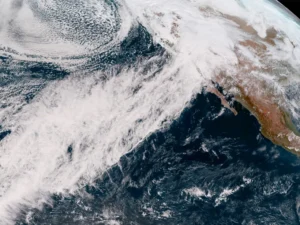
Atmospheric rivers are relatively narrow regions in the atmosphere — typically 250 to 375 miles wide and well over 1,000 miles long.
These sky rivers transport water vapor outside of the tropics to mid-latitude and polar regions. We estimate that 90% of Earth’s north to south water vapor transport is done through atmospheric rivers.
An atmospheric river is identifiable in imagery from weather satellites, appearing as elongated tendrils of moisture stretching from the tropics to the mid-latitudes. This moisture laden air moves away from the Equator and can carry enough water vapor, that if condensed to liquid form, is approximately equivalent to the amount of water carried by 25 Mississippi Rivers.
When an atmospheric river flows over land, extreme flooding events can occur, often through interactions with mid-latitude weather systems. Think of an atmospheric river as a conveyor belt that provides huge amounts of tropical moisture into mid-latitude weather systems, intensifying their rainfall. Extreme, or prolonged, precipitation can create floods, induce mud slides, and cause catastrophic damage to life and property.
Most rivers in the sky, however, are weak and simply provide beneficial rain or snow that is crucial to the water supply of a region. Atmospheric rivers are responsible for a large percentage of the rain and snow in the western United States during winter. When these rivers are forced up the sides of the Sierra Nevada mountains in California and Nevada, the water vapor is condensed into liquid and solid form, bringing much needed rains to the area.
Categorizing the flow of moisture by an atmospheric river can be a useful way to gage the likely impact of these features on precipitation. For example, an Atmospheric River Category 1 (AR Cat 1) is the weakest category and is considered primarily beneficial in terms of rainfall. An AR Cat 2 is moderate and in most situations beneficial, but can be hazardous if the resulting precipitation lasts a long time. The strongest category is AR Cat 5 and that is an exceptional and primarily hazardous event.
Steve Ackerman and Jonathan Martin, professors in the UW-Madison department of atmospheric and oceanic sciences, are guests on WHA radio (970 AM) at 11:45 a.m. the last Monday of each month. Send them your questions at stevea@ssec.wisc.edu or jemarti1@wisc.edu.

